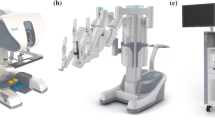Abstract
Background
Laparoscopic surgery has become the standard option for gastrointestinal surgeries. However, laparoscopic procedures require extended training times and are difficult for inexperienced surgeons. Robot-assisted laparoscopic surgery facilitates easy adaptation of laparoscopic procedures, but robotic surgical systems are expensive. In addition, their cost has remained high because there is currently only one manufacturer of commercially available systems. Recently, a new Korean robotic surgical system, Revo-i, has been developed. The aim of this study was to evaluate the feasibility and safety of Revo-i by performing robotic cholecystectomy in a porcine model.
Methods
After approval by the Institutional Animal Care and Use Committee of Yonsei University Health System, cholecystectomy was performed in four pigs using the Revo-i robotic surgical system. Operative time and perioperative complications were recorded, and all animals were observed for postoperative complications for 2 weeks after surgery
Results
Robotic cholecystectomy was completed successfully and without gallbladder perforation in all cases. The mean operative time was 78 ± 12 min, the mean docking time was 4.5 ± 2.52 min, and the mean console time was 49.8 ± 14.17 min. There were no perioperative complications, and none of the animal used for the in vivo models exhibited abnormal behavior during the postoperative observation period.
Conclusions
These preliminary results verify the safety and efficacy of robotic cholecystectomy using the Revo-i robotic surgical system. Human trials are slated to begin accordingly.



Similar content being viewed by others
References
Belli G, Fantini C, D’Agostino A, Cioffi L, Langella S, Russolillo N, Belli A (2007) Laparoscopic versus open liver resection for hepatocellular carcinoma in patients with histologically proven cirrhosis: short- and middle-term results. Surg Endosc 21(11):2004–2011
Mochiki E, Nakabayashi T, Kamimura H, Haga N, Asao T, Kuwano H (2002) Gastrointestinal recovery and outcome after laparoscopy-assisted versus conventional open distal gastrectomy for early gastric cancer. World J Surg 26(9):1145–1149
Zhang RC, Zhou YC, Mou YP, Huang CJ, Jin WW, Yan JF, Wang YX, Liao Y (2015) Laparoscopic versus open enucleation for pancreatic neoplasms: clinical outcomes and pancreatic function analysis. Surg Endosc. doi:10.1007/s00464-015-4538-6
Zhou ZG, Hu M, Li Y, Lei WZ, Yu YY, Cheng Z, Li L, Shu Y, Wang TC (2004) Laparoscopic versus open total mesorectal excision with anal sphincter preservation for low rectal cancer. Surg Endosc 18(8):1211–1215
Hawasli A, Lloyd LR (1991) Laparoscopic cholecystectomy. The learning curve: report of 50 patients. Am Surg 57(8):542–544 (discussion 545)
Jordan JA, Gallagher AG, McGuigan J, McClure N (2000) Randomly alternating image presentation during laparoscopic training leads to faster automation to the “fulcrum effect”. Endoscopy 32(4):317–321
Nio D, Bemelman WA, Busch OR, Vrouenraets BC, Gouma DJ (2004) Robot-assisted laparoscopic cholecystectomy versus conventional laparoscopic cholecystectomy: a comparative study. Surg Endosc 18(3):379–382
Cadiere GB, Himpens J, Germay O, Izizaw R, Degueldre M, Vandromme J, Capelluto E, Bruyns J (2001) Feasibility of robotic laparoscopic surgery: 146 cases. World J Surg 25(11):1467–1477
Fanfani F, Monterossi G, Fagotti A, Rossitto C, Alletti SG, Costantini B, Gallotta V, Selvaggi L, Restaino S, Scambia G (2015) The new robotic TELELAP ALF-X in gynecological surgery: single-center experience. Surg Endosc. doi:10.1007/s00464-015-4187-9
Yi B, Wang G, Li J, Jiang J, Son Z, Su H, Zhu S (2015) The first clinical use of domestically produced Chinese minimally invasive surgical robot system “Micro Hand S”. Surg Endosc. doi:10.1007/s00464-015-4506-1
Kang CM, Chi HS, Hyeung WJ, Kim KS, Choi JS, Lee WJ, Kim BR (2007) The first korean experience of telemanipulative robot-assisted laparoscopic cholecystectomy using the da vinci system. Yonsei Med J 48(3):540–545
Schostek S, Binser MJ, Rieber F, Ho CN, Schurr MO, Buess GF (2010) Artificial tactile feedback can significantly improve tissue examination through remote palpation. Surg Endosc 24(9):2299–2307
Acknowledgements
This work was supported by the National Research Foundation of Korea Grant funded by the Korean government (MEST; NRF-2015R1A2A2A04003460).
Authors’ contribution
JHL Authors make substantial contributions to conception and design, and/or acquisition of data, and/or analysis and interpretation of data; WJL Authors make substantial contributions to conception and design, and/or acquisition of data, and/or analysis and interpretation of data; DWP Authors participate in drafting the article or revising it critically for important intellectual content; HJY Authors participate in drafting the article or revising it critically for important intellectual content; SHK Authors participate in drafting the article or revising it critically for important intellectual content; CMK Authors give final approval of the version to be submitted and any revised version to be published.
Author information
Authors and Affiliations
Corresponding author
Ethics declarations
Disclosures
Woo Jung Lee serves as consultant for Meere Company Inc, Pangyo Techno Valley, Seongnam, Republic of Korea. Dong Won Park participates in development of robotic system, Meere Company Inc, Pangyo Techno Valley, Seongnam, Republic of Korea. Jin Hong Lim, Hye Jin Yea, Se Hoon Kim, Chang Moo Kang have no conflicts of interest or financial ties to disclose.
Electronic supplementary material
Below is the link to the electronic supplementary material.
Supplementary material 1 (WMV 138160 kb)
Rights and permissions
About this article
Cite this article
Lim, J.H., Lee, W.J., Park, D.W. et al. Robotic cholecystectomy using Revo-i Model MSR-5000, the newly developed Korean robotic surgical system: a preclinical study. Surg Endosc 31, 3391–3397 (2017). https://doi.org/10.1007/s00464-016-5357-0
Received:
Accepted:
Published:
Issue Date:
DOI: https://doi.org/10.1007/s00464-016-5357-0




